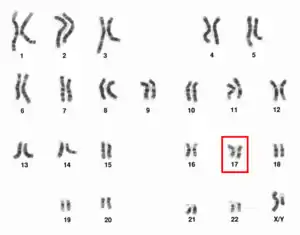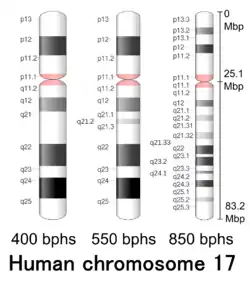Chromosome 17
Chromosome 17 is one of the 23 pairs of chromosomes in humans. People normally have two copies of this chromosome. Chromosome 17 spans more than 83 million base pairs (the building material of DNA) and represents between 2.5 and 3% of the total DNA in cells.
| Chromosome 17 | |
|---|---|
 Human chromosome 17 pair after G-banding. One is from mother, one is from father. | |
 Chromosome 17 pair in human male karyogram. | |
| Features | |
| Length (bp) | 83,257,441 bp (GRCh38)[1] |
| No. of genes | 1,124 (CCDS)[2] |
| Type | Autosome |
| Centromere position | Submetacentric[3] (25.1 Mbp[4]) |
| Complete gene lists | |
| CCDS | Gene list |
| HGNC | Gene list |
| UniProt | Gene list |
| NCBI | Gene list |
| External map viewers | |
| Ensembl | Chromosome 17 |
| Entrez | Chromosome 17 |
| NCBI | Chromosome 17 |
| UCSC | Chromosome 17 |
| Full DNA sequences | |
| RefSeq | NC_000017 (FASTA) |
| GenBank | CM000679 (FASTA) |
Chromosome 17 contains the Homeobox B gene cluster.
Genes
Number of genes
The following are some of the gene count estimates of human chromosome 17. Because researchers use different approaches to genome annotation their predictions of the number of genes on each chromosome varies (for technical details, see gene prediction). Among various projects, the collaborative consensus coding sequence project (CCDS) takes an extremely conservative strategy. So CCDS's gene number prediction represents a lower bound on the total number of human protein-coding genes.[5]
| Estimated by | Protein-coding genes | Non-coding RNA genes | Pseudogenes | Source | Release date |
|---|---|---|---|---|---|
| CCDS | 1,124 | — | — | [2] | 2016-09-08 |
| HGNC | 1,132 | 325 | 458 | [6] | 2017-05-12 |
| Ensembl | 1,184 | 1,199 | 535 | [7] | 2017-03-29 |
| UniProt | 1,169 | — | — | [8] | 2018-02-28 |
| NCBI | 1,199 | 757 | 566 | [9][10][11] | 2017-05-19 |
Gene list
The following is a partial list of genes on human chromosome 17. For complete list, see the link in the infobox on the right.
- 2700099C18Rik: encoding protein NDC80 homolog, kinetochore complex component pseudogene
- ABI3: encoding protein ABI gene family member 3
- ABR: encoding protein Abr, rhogef and gtpase activating protein
- ARHGAP44: encoding protein Rho GTPase activating protein 44
- AZI1: encoding protein 5-azacytidine-induced protein 1
- BRCA1P1: encoding protein BRCA1 pseudogene 1
- BCPR encoding protein Breast cancer-related regulator of TP53
- C17orf98: encoding protein C17orf98
- C1QL1: encoding protein complement component 1, q subcomponent-like 1
- CCDC144A: encoding protein Coiled-coil domain-containing protein 144A
- CCDC40: encoding protein Coiled-coil domain containing 40
- CCDC47: encoding protein CCDC47
- CCDC57: encoding protein Coiled-coil domain-containing protein 57
- CLUH: encoding protein Clustered mitochondria (cluA/CLU1) homolog
- CTDNEP1: encoding protein CTD nuclear envelope phosphatase 1
- DEL17P13.1 encoding protein Chromosome 17p13.1 deletion syndrome
- DHX8: encoding protein DEAH-box helicase 8
- DPH1 encoding protein Diphthamide biosynthesis protein 1
- DUP17Q12: encoding protein Chromosome 17q12 duplication syndrome
- FAM20A: encoding protein FAM20A
- GAS7: encoding protein Growth arrest-specific protein 7
- GGT6: encoding protein Gamma-glutamyltransferase 6
- HN1: encoding protein Hematological and neurological expressed 1 protein
- IBD22 encoding protein Inflammatory bowel disease-22
- LINC00511: encoding protein Long intergenic non-protein coding RNA 511
- LINC00674 encoding protein Long intergenic non-protein coding RNA 674
- LRRC37A encoding protein Leucine rich repeat containing 37A
- LRRC48: encoding protein Leucine-rich repeat-containing protein 48
- MBTD1: encoding protein Malignant Brain Tumor domain containing 1
- METTL16: encoding protein Methyltransferase like 16
- MGAT5B: encoding enzyme Alpha-1,6-mannosylglycoprotein 6-beta-N-acetylglucosaminyltransferase B
- MIR195: encoding protein MicroRNA 195
- MIR4521: encoding protein MicroRNA 4521
- MLLT6: encoding protein MLLT6, PHD finger containing
- MSI2: encoding protein Musashi RNA binding protein 2
- MYBBP1A: encoding protein Myb-binding protein 1A
- MYCBPAP: encoding protein MYCBP associated protein
- NBP: encoding peptide Neuropeptide B
- NME1-NME2:
- NXPH3: encoding protein Neurexophilin-3
- OMG: encoding protein Oligodendrocyte-myelin glycoprotein
- Ormdl sphingolipid biosynthesis regulator 3: encoding protein ORMDL sphingolipid biosynthesis regulator 3
- PLXDC1: encoding protein Plexin domain-containing protein 1
- PNPO: encoding enzyme Pyridoxine-5'-phosphate oxidase
- PPP1R27: encoding protein Protein phosphatase 1, regulatory subunit 27
- PRCD: encoding protein Progressive rod-cone degeneration
- PRPSAP2: encoding protein Phosphoribosyl pyrophosphate synthetase-associated protein 2
- PRR29: encoding protein Proline-rich protein 29
- QRICH2: encoding protein Glutamine-rich protein 2
- RAP1GAP2: encoding protein RAP1 GTPase activating protein 2
- RFFL: encoding enzyme E3 ubiquitin-protein ligase rififylin
- RNMTL1: encoding enzyme RNA methyltransferase-like protein 1
- RPAIN: encoding protein RPA-interacting protein
- RPL23A: encoding protein 60S ribosomal protein L23a
- SC65: encoding protein Synaptonemal complex protein SC65
- SCPEP1: encoding enzyme Retinoid-inducible serine carboxypeptidase
- SEBOX: encoding protein SEBOX homeobox
- SECTM1: encoding protein Secreted and transmembrane protein 1
- SEPTIN4: encoding Septin4
- SKA2: encoding protein Spindle and Kinetochore Associated
- SLC39A11: encoding protein Solute carrier family 39 member 11
- SLFN11: encoding protein Schlafen family member 11
- SLFN12: encoding protein Schlafen family member 12
- SNF8: encoding protein Vacuolar-sorting protein SNF8
- SPACA3: Sperm acrosome membrane-associated protein 3
- SPAG5: encoding protein Sperm-associated antigen 5
- ST6GALNAC1: encoding enzyme Alpha-N-acetylgalactosaminide alpha-2,6-sialyltransferase 1
- ST6GALNAC2: encoding enzyme Alpha-N-acetylgalactosaminide alpha-2,6-sialyltransferase 2
- STH: encoding protein Saitohin
- SUZ12P1 encoding protein SUZ12 polycomb repressive complex 2 subunit pseudogene 1
- TAC4: encoding protein Tachykinin-4
- TBC1D3: encoding protein TBC1 domain family member 3E/3F
- TMEM106A: encoding protein Transmembrane protein 106A
- TMEM98: encoding protein Transmembrane protein 98
- TNFSF12-TNFSF13:
- TOM1L1: encoding protein TOM1-like protein 1
- TOM1L2: encoding protein TOM1-like protein 2
- TRIM65: encoding protein Tripartite motif containing 65
- TRPV1: encoding protein Transient receptor potential cation channel subfamily V member 1
- TSEN54: encoding protein TRNA splicing endonuclease subunit 54
- TTYH2: encoding protein Tweety family member 2
- VAT1: encoding protein Synaptic vesicle membrane protein VAT-1 homolog
- VPS25: encoding protein Vacuolar protein-sorting-associated protein 25
- VPS53: encoding protein Vacuolar protein sorting 53 homolog (S. cerevisiae)
- YBX2: encoding protein Y-box-binding protein 2
- ZNF207: encoding protein Zinc finger protein 207
- ZNF830: encoding protein Zinc finger protein 830
- Several CC chemokines: CCL1, CCL2, CCL3, CCL4, CCL5, CCL7, CCL8, CCL11, CCL13, CCL14, CCL15, CCL16, CCL18, and CCL23
The following are some of the genes and their corresponding Cytogenetic location on chromosome 17:
p-arm
- FLCN: folliculin (17p11.2)
- MYO15A: myosin XVA (17p11.2)
- RAI1: retinoic acid induced 1 (17p11.2)
- PMP22: peripheral myelin protein 22 (17p12)
- CTNS: cystinosin, the lysosomal cystine transporter (17p13)
- USP6: Ubiquitin carboxyl-terminal hydrolase 6 linked to Aneurysmal bone cyst (17p13)
- ACADVL: acyl-coenzyme A dehydrogenase, very long chain (17p13.1)
- SHBG: Sex hormone binding globulin (17p13.1)
- TP53: tumor suppressor protein p53 (Li-Fraumeni syndrome), tumor suppressor gene (17p13.1)
- ASPA: aspartoacylase (Canavan disease) (17p13.3)
- GLOD4: glyoxalase domain containing 4 (17p13.3)
q-arm
- CCDC55: Coiled-coil domain-containing protein 55 (17q11.2)
- FLOT2: flotillin 2 (17q11.2)
- NF1: neurofibromin 1 (neurofibromatosis, von Recklinghausen disease, Watson disease) (17q11.2)
- SLC6A4: Serotonin transporter linked to Obsessive Compulsive Disorder (OCD) [12] (17q11.2)
- CCL4L1: C-C motif chemokine ligand 4 like 1 (17q12)
- DDX52: DExD-box helicase 52 (17q12)
- ERBB2 loca leukemia viral oncogene homolog 2, neuro/glioblastoma derived oncogene homolog (avian) (17q12)
- GRB7: Growth factor Receptor-Bound protein 7 (17q12)
- BRCA1: breast cancer 1, early onset (17q21)
- GFAP: glial fibrillary acidic protein (17q21)
- RARA or RAR-alpha: Retinoic acid receptor Alpha (involved in t(15,17) with PML) (17q21)
- MAPT gene coding for encoding tau protein (17q21.1)
- NAGLU: N-acetyl glucosaminidase, Sanfilippo B syndrome (17q21.2)
- SLC4A1: Band 3 anion transporter protein. Solute carrier family 4, member 1 (17q21.31)
- CBX1: chromobox homolog 1 (17q21.32)
- COL1A1: collagen, type I, alpha 1 (17q21.33)
- LUC7L3: LUC7 like 3 pre-mRNA splicing factor (17q21.33)
- NOG: Noggin protein (17q22)
- RPS6KB1 or S6K: Ribosomal protein S6-kinase (17q23.1)
- FTSJ3: FtsJ homolog 3 (17q23.3)
- SCN4A: Voltage-Gated Sodium Channel Subunit Alpha Nav1.4 (17q23.3)
- GALK1: galactokinase 1 (17q24)
- KCNJ2: potassium inwardly-rectifying channel, subfamily J, member 2 (17q24.3)
- ACTG1: actin, gamma 1 (17q25)
- CDC42EP4: CDC42 effector protein 4 (17q25.1)
- USH1G: Usher syndrome 1G (autosomal recessive) (17q25.1)
- CANT1: Calcium-activated nucleotidase 1 (17q25.3)
- BIRC5: Survivin (17q25.3)
- CHMP6: Charged multivesicular body protein 6 (17q25.3)
- ENPP7: ectonucleotide pyrophosphatase/phosphodiesterase 7 (17q25.3)
- EPR1: Effector cell peptidase receptor 1 (17q25.3
- RHBDF2: Rhomboid family member 2 (17q25.3)
- TMC6 and TMC8: Transmembrane channel-like 6 and 8 (epidermodysplasia verruciformis) (17q25.3)
- WT4: encoding protein Wilms tumor-4
Diseases and disorders

The following diseases are related to genes on chromosome 17:
- 17q12 microdeletion syndrome
- Koolen–de Vries syndrome
- Alexander disease
- Andersen–Tawil syndrome
- Aneurysmal bone cyst
- Birt–Hogg–Dubé syndrome
- Bladder cancer
- Breast cancer
- Bruck syndrome
- Campomelic dysplasia
- Canavan disease
- Cerebroretinal microangiopathy with calcifications and cysts
- Charcot–Marie–Tooth disease
- Chronic lymphocytic leukaemia, tp53
- Corticobasal degeneration
- Cystinosis
- Depression
- Ehlers–Danlos syndrome
- Epidermodysplasia verruciformis
- Frontotemporal dementia and parkinsonism linked to chromosome 17
- Galactosemia
- Glycogen storage disease type II (Pompe disease)
- Hereditary neuropathy with liability to pressure palsies
- Howel–Evans syndrome
- Li–Fraumeni syndrome
- Maturity onset diabetes of the young type 5
- Miller–Dieker syndrome
- Multiple synostoses syndrome
- Neurofibromatosis type I
- Nonsyndromic deafness
- Obsessive–compulsive disorder
- Osteogenesis imperfecta
- Potocki–Lupski syndrome
- Proximal symphalangism
- Sanfilippo syndrome
- Smith–Magenis syndrome
- Usher syndrome
- Very long-chain acyl-coenzyme A dehydrogenase deficiency
- Von Gierke's syndrome
Cytogenetic band
| Chr. | Arm[18] | Band[19] | ISCN start[20] |
ISCN stop[20] |
Basepair start |
Basepair stop |
Stain[21] | Density |
|---|---|---|---|---|---|---|---|---|
| 17 | p | 13.3 | 0 | 385 | 1 | 3,400,000 | gneg | |
| 17 | p | 13.2 | 385 | 550 | 3,400,001 | 6,500,000 | gpos | 50 |
| 17 | p | 13.1 | 550 | 784 | 6,500,001 | 10,800,000 | gneg | |
| 17 | p | 12 | 784 | 990 | 10,800,001 | 16,100,000 | gpos | 75 |
| 17 | p | 11.2 | 990 | 1499 | 16,100,001 | 22,700,000 | gneg | |
| 17 | p | 11.1 | 1499 | 1664 | 22,700,001 | 25,100,000 | acen | |
| 17 | q | 11.1 | 1664 | 1815 | 25,100,001 | 27,400,000 | acen | |
| 17 | q | 11.2 | 1815 | 2104 | 27,400,001 | 33,500,000 | gneg | |
| 17 | q | 12 | 2104 | 2255 | 33,500,001 | 39,800,000 | gpos | 50 |
| 17 | q | 21.1 | 2255 | 2461 | 39,800,001 | 40,200,000 | gneg | |
| 17 | q | 21.2 | 2461 | 2599 | 40,200,001 | 42,800,000 | gpos | 25 |
| 17 | q | 21.31 | 2599 | 2874 | 42,800,001 | 46,800,000 | gneg | |
| 17 | q | 21.32 | 2874 | 3025 | 46,800,001 | 49,300,000 | gpos | 25 |
| 17 | q | 21.33 | 3025 | 3176 | 49,300,001 | 52,100,000 | gneg | |
| 17 | q | 22 | 3176 | 3383 | 52,100,001 | 59,500,000 | gpos | 75 |
| 17 | q | 23.1 | 3383 | 3451 | 59,500,001 | 60,200,000 | gneg | |
| 17 | q | 23.2 | 3451 | 3658 | 60,200,001 | 63,100,000 | gpos | 75 |
| 17 | q | 23.3 | 3658 | 3781 | 63,100,001 | 64,600,000 | gneg | |
| 17 | q | 24.1 | 3781 | 3850 | 64,600,001 | 66,200,000 | gpos | 50 |
| 17 | q | 24.2 | 3850 | 4001 | 66,200,001 | 69,100,000 | gneg | |
| 17 | q | 24.3 | 4001 | 4166 | 69,100,001 | 72,900,000 | gpos | 75 |
| 17 | q | 25.1 | 4166 | 4400 | 72,900,001 | 76,800,000 | gneg | |
| 17 | q | 25.2 | 4400 | 4510 | 76,800,001 | 77,200,000 | gpos | 25 |
| 17 | q | 25.3 | 4510 | 4950 | 77,200,001 | 83,257,441 | gneg |
References
- "Human Genome Assembly GRCh38 - Genome Reference Consortium". National Center for Biotechnology Information. 2013-12-24. Retrieved 2017-03-04.
- "Search results - 17[CHR] AND "Homo sapiens"[Organism] AND ("has ccds"[Properties] AND alive[prop]) - Gene". NCBI. CCDS Release 20 for Homo sapiens. 2016-09-08. Retrieved 2017-05-28.
- Tom Strachan; Andrew Read (2 April 2010). Human Molecular Genetics. Garland Science. p. 45. ISBN 978-1-136-84407-2.
- Genome Decoration Page, NCBI. Ideogram data for Homo sapience (850 bphs, Assembly GRCh38.p3). Last update 2014-06-03. Retrieved 2017-04-26.
- Pertea M, Salzberg SL (2010). "Between a chicken and a grape: estimating the number of human genes". Genome Biol. 11 (5): 206. doi:10.1186/gb-2010-11-5-206. PMC 2898077. PMID 20441615.
- "Statistics & Downloads for chromosome 17". HUGO Gene Nomenclature Committee. 2017-05-12. Retrieved 2017-05-19.
- "Chromosome 17: Chromosome summary - Homo sapiens". Ensembl Release 88. 2017-03-29. Retrieved 2017-05-19.
- "Human chromosome 17: entries, gene names and cross-references to MIM". UniProt. 2018-02-28. Retrieved 2018-03-16.
- "Search results - 17[CHR] AND "Homo sapiens"[Organism] AND ("genetype protein coding"[Properties] AND alive[prop]) - Gene". NCBI. 2017-05-19. Retrieved 2017-05-20.
- "Search results - 9[CHR] AND "Homo sapiens"[Organism] AND ( ("genetype miscrna"[Properties] OR "genetype ncrna"[Properties] OR "genetype rrna"[Properties] OR "genetype trna"[Properties] OR "genetype scrna"[Properties] OR "genetype snrna"[Properties] OR "genetype snorna"[Properties]) NOT "genetype protein coding"[Properties] AND alive[prop]) - Gene". NCBI. 2017-05-19. Retrieved 2017-05-20.
- "Search results - 17[CHR] AND "Homo sapiens"[Organism] AND ("genetype pseudo"[Properties] AND alive[prop]) - Gene". NCBI. 2017-05-19. Retrieved 2017-05-20.
- "Obsessive Compulsive Disorder". An Online Catalog of Human Genes and Genetic Disorders.
- Genome Decoration Page, NCBI. Ideogram data for Homo sapience (400 bphs, Assembly GRCh38.p3). Last update 2014-03-04. Retrieved 2017-04-26.
- Genome Decoration Page, NCBI. Ideogram data for Homo sapience (550 bphs, Assembly GRCh38.p3). Last update 2015-08-11. Retrieved 2017-04-26.
- International Standing Committee on Human Cytogenetic Nomenclature (2013). ISCN 2013: An International System for Human Cytogenetic Nomenclature (2013). Karger Medical and Scientific Publishers. ISBN 978-3-318-02253-7.
- Sethakulvichai, W.; Manitpornsut, S.; Wiboonrat, M.; Lilakiatsakun, W.; Assawamakin, A.; Tongsima, S. (2012). "Estimation of band level resolutions of human chromosome images". In Computer Science and Software Engineering (JCSSE), 2012 International Joint Conference on: 276–282. doi:10.1109/JCSSE.2012.6261965. ISBN 978-1-4673-1921-8. S2CID 16666470.
- Genome Decoration Page, NCBI. Ideogram data for Homo sapience (850 bphs, Assembly GRCh38.p3). Last update 2014-06-03. Retrieved 2017-04-26.
- "p": Short arm; "q": Long arm.
- For cytogenetic banding nomenclature, see article locus.
- These values (ISCN start/stop) are based on the length of bands/ideograms from the ISCN book, An International System for Human Cytogenetic Nomenclature (2013). Arbitrary unit.
- gpos: Region which is positively stained by G banding, generally AT-rich and gene poor; gneg: Region which is negatively stained by G banding, generally CG-rich and gene rich; acen Centromere. var: Variable region; stalk: Stalk.
- Gilbert F (1998). "Disease genes and chromosomes: disease maps of the human genome. Chromosome 17". Genet Test. 2 (4): 357–81. doi:10.1089/gte.1998.2.357. PMID 10464617.
- Gene Card Website https://www.genecards.org/cgi-bin/carddisp.pl?gene=SCN4A
External links
- National Institutes of Health. "Chromosome 17". Genetics Home Reference. Archived from the original on 2007-06-30. Retrieved 2017-05-06.
- "Chromosome 17". Human Genome Project Information Archive 1990–2003. Retrieved 2017-05-06.

